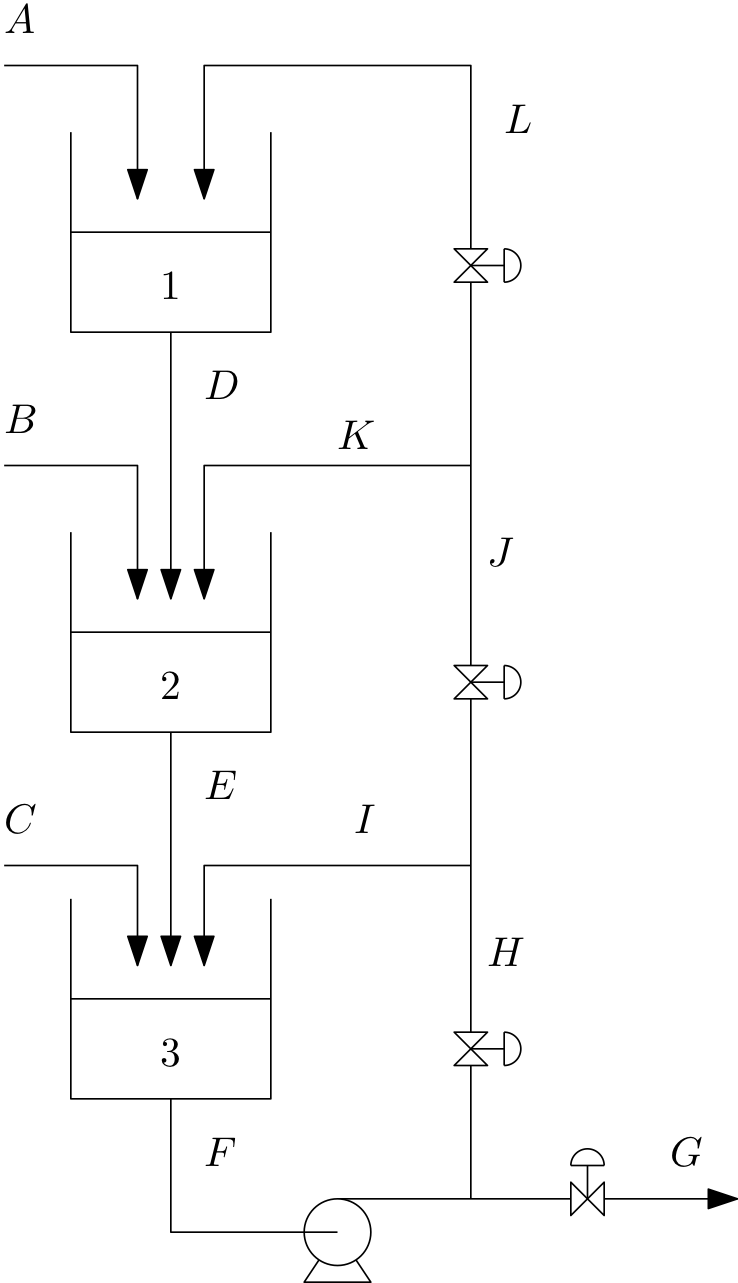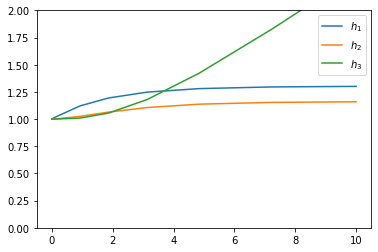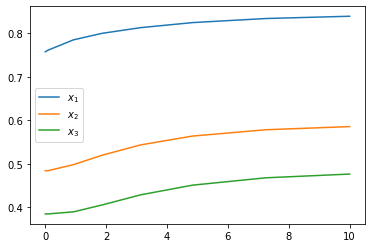6. Mixing system
Problem statement: The figure below shows a set of well-mixed mixing tanks. All the streams contain a binary mixture of substance X and substance Y. Steams A, B and C are fed into the system from an upstream process.
Tanks 1 and 2 are drained by the force of gravity (assume flow is proportional to level), while the pump attached to the tank 3 output is sized such that the level in tank 3 does not affect the flowrate through the pump.
You may assume that the valves in lines G, H, J and L can manipulate those flows directly.
The density of substance X is ρX = 1000 kg/m3 and the density of substance Y is ρY = 800 kg/m3.

7. Steady state calculation
Find the steady state flow rates and compositions of all the streams given that 3 * Stream A is 1m3/h of substance X * Streams B and C are both 1m3/h of substance Y. * H=G,H=2J,J=2L.
7.1. Flow rates
[1]:
ρx = 1000 # kg/m3
ρy = 800 # kg/m3
A = 1*ρx
B = 1*ρy
C = 1*ρy
[2]:
G = A + B + C
[3]:
H = G
J = H/2
L = J/2
[4]:
F = G + H
[5]:
D = A + L
[6]:
K = J - L
I = H - J
[7]:
E = B + D + K
[8]:
A, B, C, D, E, F, G, H, I, J, K, L
[8]:
(1000,
800,
800,
1650.0,
3100.0,
5200,
2600,
2600,
1300.0,
1300.0,
650.0,
650.0)
7.2. Compositions
[9]:
xA = 1
xB = 0
xC = 0
[10]:
xG = (xA*A + xB*B + xC*C)/G
[11]:
x3 = xF = xH = xI = xJ = xK = xL = xG
[12]:
x1 = xD = (xA*A + xL*L)/D
[13]:
x2 = xE = (xB*B + xD*D + xK*K)/E
8. Design
Assuming all three tanks are of constant cross-sectional area of 3m2, find out what the proportionality constants should be for tank 1 and 2 so that the steady state levels will be 1 m.
[14]:
A1 = A2 = A3 = 3
[15]:
h1 = h2 = h3 = 1
[16]:
k1 = D/h1
[17]:
k2 = E/h2
[18]:
k1, k2
[18]:
(1650.0, 3100.0)
9. Dynamic simulation
Now that you have all the parameters in your system, simulate the response of the system to a sudden increase in flow rate of A from 1 m3/h to 1.5 m3/h at time 0. You should start your simulation at steady state.
Assume that the level in tank 3 is also 1 m at the initial conditions. Note that the steady state relationships between H, G, J and L will not hold over the whole simulation. Simply set them to their steady state values.
[19]:
import scipy.integrate
Our states will be the total masses and mass of X in each tank. Let’s find the initial values at steady state first:
Find volumes via tank geometry
[20]:
V1 = A1*h1
V2 = A2*h2
V3 = A3*h3
Masses from volumes - assume ideal mixing
[21]:
M1 = V1/(x1/ρx + (1 - x1)/ρy)
M2 = V2/(x2/ρx + (1 - x2)/ρy)
M3 = V3/(x3/ρx + (1 - x3)/ρy)
[22]:
y0 = [M1, M2, M3, M1*x1, M2*x2, M3*x3]
[23]:
t = 0
[24]:
def dMdt(t, y):
M1, M2, M3, M1x1, M2x2, M3x3 = y
if t <= 0:
A = 1*ρx
else:
A = 1.5*ρx
xD = x1 = M1x1/M1
xE = x2 = M2x2/M2
xF = x3 = M3x3/M3
V1 = M1*(x1/ρx + (1 - x1)/ρy)
V2 = M2*(x2/ρx + (1 - x2)/ρy)
V3 = M3*(x3/ρx + (1 - x3)/ρy)
h1 = V1/A1
h2 = V2/A2
h3 = V3/A3
xH = xI = xJ = xK = xL = xG = x3
D = k1*h1
E = k2*h2
dM1dt = A + L - D
dM2dt = B + D + K - E
dM3dt = C + E + I - F
dM1x1dt = xA*A + xL*L - xD*D
dM2x2dt = xB*B + xD*D + xK*K - xE*E
dM3x3dt = xC*C + xE*E + xI*I - xF*F
return dM1dt, dM2dt, dM3dt, dM1x1dt, dM2x2dt, dM3x3dt
We expect t=0 to give zero derivatives
[25]:
dMdt(0, y0)
[25]:
(0.0,
4.547473508864641e-13,
0.0,
0.0,
4.547473508864641e-13,
-4.547473508864641e-13)
And for other times to give non-zero derivatives
[26]:
dMdt(1, y0)
[26]:
(500.0,
4.547473508864641e-13,
0.0,
500.0,
4.547473508864641e-13,
-4.547473508864641e-13)
[27]:
sol = scipy.integrate.solve_ivp(dMdt, (0, 10), y0)
[28]:
sol
[28]:
message: 'The solver successfully reached the end of the integration interval.'
nfev: 68
njev: 0
nlu: 0
sol: None
status: 0
success: True
t: array([0.00000000e+00, 1.00000000e-04, 9.32930762e-04, 9.26223838e-03,
9.25553145e-02, 9.25486076e-01, 1.86268269e+00, 3.13373601e+00,
4.83441945e+00, 7.23515873e+00, 9.99326358e+00, 1.00000000e+01])
t_events: None
y: array([[2828.57142857, 2828.61687016, 2829.03321934, 2833.18623756,
2873.68652849, 3191.18414035, 3411.4077485 , 3576.81492267,
3679.20042145, 3732.50482985, 3751.73742159, 3751.76206113],
[2657.14285714, 2657.14285827, 2657.14297442, 2657.1545728 ,
2658.2647728 , 2730.90792703, 2850.15605228, 2978.77726282,
3075.5278406 , 3130.61308859, 3150.4898384 , 3150.51308613],
[2600. , 2600. , 2600.00000004, 2600.00003725,
2600.0360844 , 2626.36069917, 2755.48727041, 3096.98554741,
3748.1911919 , 4840.17117488, 6180.11425868, 6183.43458116],
[2142.85714286, 2142.90258442, 2143.31893191, 2147.4717797 ,
2187.95586832, 2505.19417937, 2729.14975288, 2908.4244449 ,
3034.24936155, 3113.23792305, 3148.959073 , 3149.01344238],
[1285.71428571, 1285.71428686, 1285.71440471, 1285.72617038,
1286.84986914, 1359.78761856, 1480.91665298, 1618.72961343,
1733.52304584, 1810.12997441, 1844.51567419, 1844.56643364],
[1000. , 1000. , 1000.00000004, 1000.00004033,
1000.03821936, 1022.64243623, 1116.4204006 , 1327.1016063 ,
1689.48149947, 2263.4913374 , 2943.38602418, 2945.04374286]])
Plot the composition of stream G as well as the compositions and levels in all three tanks.
[29]:
import matplotlib.pyplot as plt
%matplotlib inline
[30]:
M1, M2, M3, M1x1, M2x2, M3x3 = sol.y
[31]:
x1 = M1x1/M1
x2 = M2x2/M2
x3 = M3x3/M3
V1 = M1*(x1/ρx + (1 - x1)/ρy)
V2 = M2*(x2/ρx + (1 - x2)/ρy)
V3 = M3*(x3/ρx + (1 - x3)/ρy)
h1 = V1/A1
h2 = V2/A2
h3 = V3/A3
[32]:
plt.plot(sol.t, h1,
sol.t, h2,
sol.t, h3)
plt.ylim(0, 2)
plt.legend(['$h_1$', '$h_2$', '$h_3$'])
[32]:
<matplotlib.legend.Legend at 0x1519b93c50>

[33]:
plt.plot(sol.t, x1,
sol.t, x2,
sol.t, x3)
plt.legend(['$x_1$', '$x_2$', '$x_3$'])
[33]:
<matplotlib.legend.Legend at 0x1519bf0e10>

[ ]: